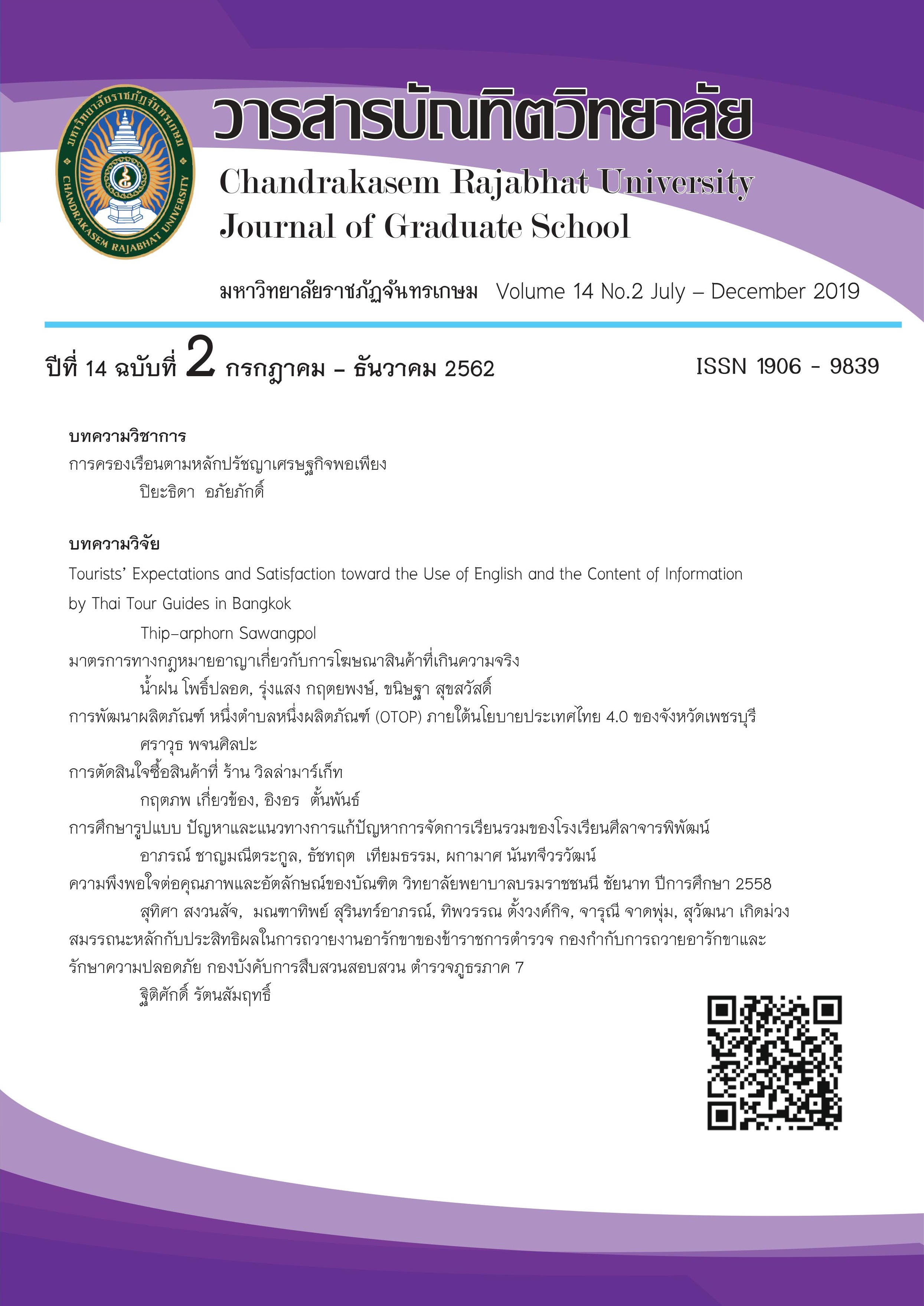Tourists’ Expectations and Satisfaction toward the Use of English and the Content of Information by Thai Tour Guides in Bangkok
Main Article Content
บทคัดย่อ
The tourism sector is one of the most important economic sectors in Thailand. A tour guide represents an important role on tourist satisfaction and intention for re-visiting. Understanding tourist expectations and satisfaction would provide strategies for developing better services of the tour guides. The objectives of this study are to investigate the level of tourist expectations and satisfaction of the English use and content of Thai tour guides and to provide recommendations to develop the training courses. Using Bangkok as a case study, a total of 106 questionnaires were collected with the help of tour guides during the tour conduction. Data were analyzed using factor analysis, hypothesis testing, multiple regression analysis, and K-means cluster analysis.
Findings revealed that the delivered message was the most important factor towards tourist satisfaction and followed by the English use of the tour guides. The sampled tourists came to Bangkok with higher expectations and left with higher satisfaction levels for the content of information provided. It is recommended that Thai tour guides must be improved in terms of grammatical correctness, use of vocabularies, technical terms and expressions, delivery of the messages, and understandable stress, accents and pronunciation. Findings from this study provide insights into both tourism industry and academic areas to improve services of the tour guides and to revise curriculums to meet tourist expectations.
Article Details
เอกสารอ้างอิง
Bowie, D., & Chang, J. C. (2005). Tourist satisfaction: A view from a mixed international guided package tour. Journal of Vacation Marketing, 11(4), 303-322.
Chen, C., & Chen, F. (2010). Experience Quality, Perceived Value, Satisfaction and behavioral intentions for heritage tourists. Tourism Management, 31, 29-35. Retrieved February 08, 2009, from http://dx.doi.org/10.1016/j.tourman.
European Federation of Tourist Guide Associations (FEG). (n.d.). About the european federation of tourist guide associations (FEG). Retrieved October 21, 2017, from http://www.feg-touristguides.com/about.php
Field, A. (2009). Discovering Statistics using SPSS. London, England: Sage Publications.
Huang, S., Hsu, C. H. C., & Chan, A. (2010). Tour guide performance and tourist satisfaction: A study of the package tours in Shanghai. Journal of Hospitality & Tourism Research, 34(1), 3-33.
Huh, J., Uysal, M., & McCleary, K. (2006). Cultural/Heritage destinations: Tourist satisfaction and market segmentation. Journal of Hospitality and Leisure Marketing, 14(3), 81-99.
Korzay, M., & Alvarez, M. D. (2005). Satisfaction and dissatisfaction of Japanese tourists in Turkey. Anatolia, An International Journal of Tourism and Hospitality Research, 16(2), 176-193.
Mak, A. H. N., Wong, K. K. F., & Chang, R. C. Y. (2010). Factors affecting the service quality of the tour guiding profession in Macau. International Journal of Tourism Research, 12(3), 205-218.
Meemark, M. (2002). An analysis of needs and problems of English for tourist police (Unpublished master’s thesis). Mahidol University, Bangkok.
O’Brien, T. W., & Ham, S. H. (2012). Toward Professionalism in Tour Guiding – A Manual for Trainer.
Washington, DC: United States Agency for International Development.
Pizam, A., & Ellis, T. (1999). Customer satisfaction and its measurement in hospitality enterprises. International Journal of Contemporary Hospitality Management, 11(7), 326-339.
Prachanant, N. (2012). Need analysis on English language use in tourism industry. The 8th International Language
for Specific Purposes (LSP) Seminar – Aligning Theoretical Knowledge with Professional Practice, 117-125.
Reisinger, Y., & Turner, L. W. (2003). Cross-Cultural behavior in tourism: Concepts and analysis. Oxford: Butterworth-Heinemann.
Sekaran, U., & Bougie, R. (2013). Research methods for business: A skill building approach. West Sussex: John Wiley & Sons.
Severt, D., Wong, Y., Chen, P., & Breiter, D. (2007). Examining the motivation, perceived performance and behavioral intentions of convention attendees: Evidence from a regional conference. Tourism Management, 28(2), 399-408. Retrieved November 29, 2017 from, http://dx.doi.org/10.1016/j.tourman.2006.04.003
Spears, D. L., & Rosenbaum, M. S. (2012). The packaged tourist: A Japanese and American perspective. tourismos: An International Multidisciplinary. Journal of Tourism, 7(1), 19–40.
Truong, T. H., & Foster, D. (2006). Using HOLSAT to evaluate tourist satisfaction at destinations: The case of Australian holidaymakers in Vietnam. Tourism Management, 27(5), 842-855.
Wong, K. Ap. J., & Sandiford, P. (1998). Professional Tour Guiding: An exploratory investigation of Current Practices. In Conference Proceedings: The Fourth Asia Pacific Tourism Association Conference, Tanyan, Korea, 18–21 August 1998 (pp. 256 –260). Busan, Korea: Asia Pacific Tourism Association.
Yoon Y., & Uysal, M. (2005). An examination of the effects of motivation and satisfaction on destination loyalty: a structural model. Tourism Management, 26(1), 45-56.
Zhang, H. Q., & Chow, I. (2004). Application of importance-performance model in tour guides’ performance: evidence from mainland Chinese outbound visitors in Hong Kong. Tourism Management, 25(1), 81-91.


